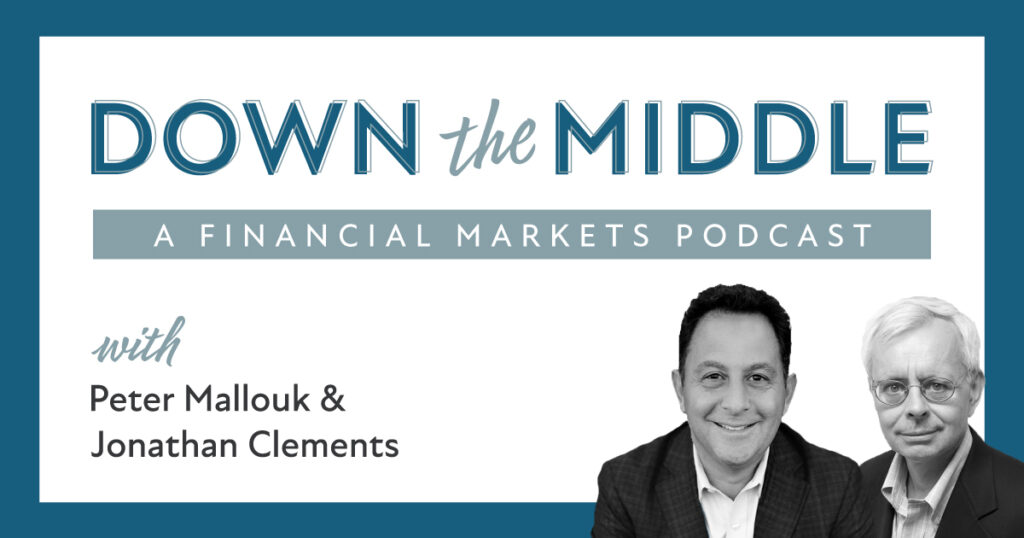This month, Peter Mallouk and Jonathan Clements discuss today’s widespread pessimism — and why it should make investors optimistic about the financial markets. They also discuss opportunities presented by this (and every) bear market and offer tips on Roth conversions and term life insurance.
Hosted by Creative Planning Director of Financial Education, Jonathan Clements, and President, Peter Mallouk, this podcast takes a closer look into topics that affect investors. Included are in-depth discussions on financial planning issues, the economy and the markets. Plus, you won’t want to miss each of their monthly tips!
Have questions or topic suggestions?
Email us @ podcasts@creativeplanning.com
Transcript:
Jonathan Clements: Hello, this is Jonathan Clements, director of Financial Education for Creative Planning in Overland Park, Kansas. With me is Peter Mallouk, President of the firm. We are Down the Middle. Today, there’s widespread pessimism about stocks, about bonds, about inflation, about economic growth. So contrarians that we are, we’re devoting this month’s podcast to reasons to be optimistic about the financial market. And ironically, a big reason to be optimistic is the widespread pessimism. Peter, why don’t you explain that one for listeners?
Peter Mallouk: First of all, this is our 26th bear market and depends how far back in history you want to go, but let’s just say in the modern era. There have been 27 bull markets. One thing we know. Is that every single time there’s been a bear market in the United States, it’s worked itself out at its given way to the bull. The trades and the discipline that an investor exhibits in the bear market are really preparation for the bull market. That’s really what it’s all about. If you think about the things that people were complaining about just a year ago. Oh, bond yields are too low. How would I ever buy bonds when bond yields are too low or the stock markets at all time high. I don’t like investing when it’s an all time high.
Here we are. Bond yields are higher. If you’re a new investor, congrats, bond yields are paying more than they were a couple years ago. If you are a current investor, your bonds are paying income to you. The income is going to buy, in many cases, other bonds. So you are replacing these expiring bonds, these maturing bonds, with higher yielding bonds. If you had a CD and interest rates went up and your CD matured, and you got to buy a higher CD, you’d be happy, right? There’s this opportunity to get the yield part of the portfolio to actually work out for you. The stocks don’t have to do all the heavy lifting. If we go over to the stock side of things, a lot of people want to buy things when they’re on sale, but they don’t want to buy stocks when they’re on sale.
That’s when you should really be buying stocks. If you’re a new investor, you’re a dollar cost average, and you’re a contributing to 401k, or you’re still in your working years and you’re saving, this is a gift. You want to contribute as much as you can in a down market. You want to be contributing through a 9-11 bear market, a tech bubble bear market, a pandemic bear market and through this bear market. Those are the times you should be accumulating as much as you can, accelerating your 401k contributions, and so on. If you’re fully invested, you’re not earning any more money, it’s an opportunity to rebalance into the lower performing asset classes that you believe in. It’s an opportunity to place tax trades. It’s an opportunity to reinvest your dividends at lower prices for share. This is really the time when you look at the difference between a good investor and a great investor. The great investor takes advantage of the bear market. The bear market presents the opportunity. A great investor rides along in the bull market and takes advantage of the bear market.
Jonathan: One of the reasons why you want to take advantage during a bear market is because even though the financial markets tend to be reasonably efficient, which is why I personally am a big fan of index funds, even though the financial markets tend to be reasonably efficient. The fact is during bull markets, investors tend to get too exuberant and stock prices may overshoot a little bit on the upside. Similarly, during bear markets, investors become too pessimistic and we tend to see a little bit of overshoot on the downside. I don’t know whether we’re overshooting on the downside right now, but the fact is we do have the broad bond market down 10% in 2022. We do have the broad U.S. Stock Market down 17% or 18% in 2022. For folks who were lamenting last year about how low bond yields were and how high stock prices were, guess what, you’ve been presented with your opportunity.
This is not the time to be sitting on your hands or carrying in cash. This is the time to act. The financial markets are giving you a gift and you should take advantage of it. Not only Peter, have we seen stock and bump prices fall, but also at this point, it appears as other financial markets are stabilizing below for both the S&P 500 and the 10 year treasury note. Where back in mid-June, there’s a lot of bad news still, but it seems like that bad news is no longer triggering, widespread selling by investors. One consequence of that is that the S&P 500 is now trading around 20 times trailing 12-month reported earnings, which is right at the average for the past 20 years. Do you think stocks are attractively priced at this point?
Peter: I think they’re not overvalued, but you never know where the bottom is. Even though we’ve had a breather for a little while and we’re off our lows and some sectors are way off their lows, it’s too early to tell. I think what the market’s looking at is seeing the Fed is raised rates aggressively, and we’ve seen it start to contain inflation. We’ve seen commodity prices roll over. A lot of commodity prices have come substantially down from lumber to cotton and everything in between. Not everything but almost everything in between. So it’s seeing that the increase in rates is working yet. Unemployment has remained very low. It’s very hard to have a prolonged recession with very low unemployment. In fact, the fed would like unemployment to be a little bit higher. So it seems that we’re heading in the right direction. Of course, there’s a lot of variables.
There’s Ukraine, there’s energy, then there’s the fed, then there’s politics. Then there’s all the things in between and things we’re not thinking about. So the market’s too dynamic to call a bottom as you know, better than anybody. I was reading you write about that long before I did, but it’s definitely not. It’s definitely not a heated market. The heat is out of the market. This is something where if you’re a three year, if you got a three year time horizon, you’re extremely likely to be rewarded for investing during this period.
Jonathan: One of the things that people should keep in mind is that the stock market’s going to bottom before the bad economic news is over. Historically, the stock market is tended to bottom about six months before the worst of the economic news. We may see the stock market rally. In fact, we will see the stock market rally, even as the numbers are getting worse. One of the reasons the numbers are going to be worse, in terms of at least unemployment and economic growth, is because of the Federal Reserve’s aggressive move to raise short term interest rates. The fear is that’s going to tip the economy into recession still. There’s a silver lining to this move toward higher rates. Doesn’t that mean Peter that the Fed will be in a better position to respond to future economic turmoil?
Peter: If you look at the last four major bear markets, we just rolled through, from the pandemic, 9-11, and so on, the Federal Reserve was lowering rates to get the economy going again. Now that they’ve raised rates, if something does happen that’s unexpected, another pandemic of some kind, another war of some kind, a cyber attack or something we’ve not experienced before that we’re not thinking about, they now have the capability to use their most effective tool to restimulate the economy. They’ve now raised rates enough that they have room to lower them if they need to in the future. It’s a much better spot than the vulnerability that we’ve had in past bear markets, where the feds going near zero, and they’re really kind of out of bullets if something goes wrong. That’s another reason to feel pretty good about the direction of this bear market. Bear markets are not good in general, but if you’re going to have them, this is the kind of one that you want to have to go through.
Jonathan: All right, Peter. So finally, it’s that time of the podcast time for our financial wellness tip of the month! What do you have for me, Peter?
Peter: I’ve seen in my career, a couple families just get wiped out by not having the right Term Life insurance coverage. Term Life insurance is extremely inexpensive. If you are 30 years old, 40 years old, 50 years old, and your family needs money to finish paying for the house, college, and paying off debts. If you’re gone and have some money to sustain themselves a term insurance policy, usually for hundreds of dollars, can make sure the family has the money that they need to cover them in the event you pass the next 10, 15, or 20 years. Really the consequences of not having it, if it’s needed, are very, very significant. A lot of people moved into bigger homes. They made major purchases. They have debt. It’s time to reexamine your Term insurance and make sure that the family has enough to cover their needs in the event that you part ways with Earth early.
Jonathan: Peter, my tip of the month is to consider converting part of your Traditional IRA to a Roth. I think this is a great time to do it. You’ve got the stock market down sharply, so you can convert the same dollar amount, but convert a larger portion of your traditional IRA to a Roth to the extent that we get a rally in the financial markets from here. That growth will be tax free to you. The one caveat here is what you need to look at your tax situation, talk to your financial advisor, talk to your accountant and make sure it does indeed make sense to you. If you do it, make sure that you have enough money sitting in cash in a regular taxable account to pay the resulting tax bill.
I actually believe that this is good enough advice that I just did it. Within the last couple of weeks, I converted $60,000 of my traditional IRA to a Roth. It makes sense for me for a tax point of view. If it makes sense to you, dear listener, to also do it, I’d seriously consider it. So anyway, Peter, that’s it for this month. This is Jonathan Clements, Director of Financial Education for Creative Planning. I’ve been talking to Peter Mallouk, President of the firm, and we are down the middle.
Disclosure: This commentary is provided for general information purposes only, and should not be construed as investment, tax or legal advice. Past performance of any market results is no assurance of future performance. The information contained herein has been obtained from sources deemed reliable, but is not guaranteed.





